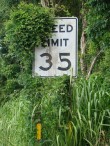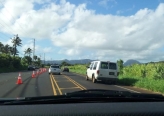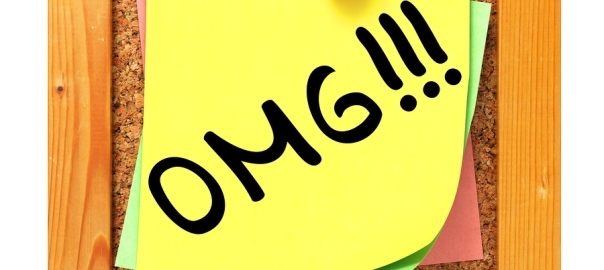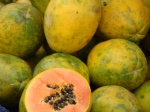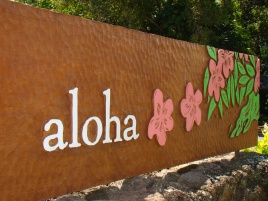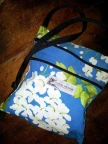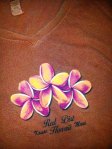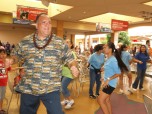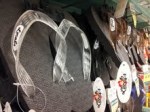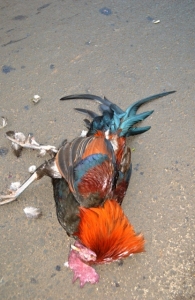 A vacation on any Hawaiian island can give visitors “sticker shock,” so it should come as no surprise that the “price of paradise” is even more pronounced when you fly to the outer island of Kauai where the cost of living is about double the national average.
A vacation on any Hawaiian island can give visitors “sticker shock,” so it should come as no surprise that the “price of paradise” is even more pronounced when you fly to the outer island of Kauai where the cost of living is about double the national average.
Shipping costs, some of the highest gas prices in the nation, plus the most shocking energy prices in the U-S are among the factors adding to the loud “ka-ching” you’ll hear at the cash register. To add insult to injury, a 4% excise tax is added to everything you buy on the Garden Isle.
One of the most noticeable price differentials for visitors from the mainland is the cost of food. I remember my brother and sister-in-law gasping for breath during their vacation when they saw milk for sale in a local supermarket for more than $5.00/gallon, eggs for around $4/dozen and bread for nearly $6/loaf.
Other areas where you’ll suffer sticker shock: –Gas is a buck more a gallon than the mainland average, rental car prices spike when supplies are tight, and you’ll cough up (pun intended) between $10 to $12/pack for name brand cigarettes.
But enough whining about the high prices on Kauai! You’re coming for a visit and hope you won’t get totally screwed, right? I can’t promise a bunch of “bargains,” but I’ll use the rest of this blog to suggest some ways to stretch your vacation dollars as far as possible.
**If you’re a local, or a frequent visitor, feel free to add your suggestions in the comments section below.**
Food:
 If you’re coming to Kauai for an extended stay with access to a kitchen, you’ll find the lowest food prices on Kauai at the Costco membership warehouse in Lihue. Even if you don’t have a Costco card, the food court is located outside, so you can still stop by for a cheap hot dog, slice of pizza, or chicken caesar salad when you’re hungry.
If you’re coming to Kauai for an extended stay with access to a kitchen, you’ll find the lowest food prices on Kauai at the Costco membership warehouse in Lihue. Even if you don’t have a Costco card, the food court is located outside, so you can still stop by for a cheap hot dog, slice of pizza, or chicken caesar salad when you’re hungry.
I suggest you skip some of the generic food you routinely eat at home and try a few of Costco’s local items like fresh opah, pork lau lau, and Kauai coffee. Some of my other favorites include Koloa Rum, macadamia nut kisses and spicy ahi tuna jerky, found in the refrigerated deli section.
Cost-U-Less in Kapa’a is another discount warehouse with no membership card required. They carry smaller quantity packaging and offer a good selection of organic food, local meats and produce. They also carry eco-friendly detergent, cleaning supplies and paper products, with lower prices than the local health food stores.
Walmart, Lihue, has good prices on milk, eggs and other necessities, plus some frozen foods, but no produce.
Kmart, Lihue, has reasonably priced food items and other necessities, plus a small selection of fresh fruits and vegetables, but no ice cream or frozen foods.
 Foodland, Times/Big Save and Safeway are the major supermarket chains on Kauai and all offer weekly specials. Note: The Safeway Club Card you use on the mainland, should work on Kauai. You no longer need a “Makai” card to qualify for Foodland’s discount prices, instead, just share your phone number at checkout, and no discount card is required at Times/Big Save. Stores with delis will often offer a selection of local favorites like Huli, huli chicken, poke, and SPAM musubi, pictured at right.
Foodland, Times/Big Save and Safeway are the major supermarket chains on Kauai and all offer weekly specials. Note: The Safeway Club Card you use on the mainland, should work on Kauai. You no longer need a “Makai” card to qualify for Foodland’s discount prices, instead, just share your phone number at checkout, and no discount card is required at Times/Big Save. Stores with delis will often offer a selection of local favorites like Huli, huli chicken, poke, and SPAM musubi, pictured at right.
Farmer’s markets are a great way to buy the freshest fruits, flowers and vegetables while supporting local farmers and helping Kauai become more self-sustainable (Sadly, 90% of the island’s food is currently imported). The Saturday market in Hanalei is a favorite among visitors because it includes a spectacular backdrop of mountains with an amazing display of tropical fruits and vegetables that create what I call “edible art.” Smaller, but equally wonderful farmer’s markets take place in all areas of Kauai nearly every day of the year, so I encourage you to put at least one of them on your vacation “bucket list.”
Kauai also offers roadside “honor stands” where you put your money in a jar/box after you select the fruits, vegetables or flowers you want to buy. You’ll also see random cars/trucks parked along the highway with locals selling everything from freshly caught fish, to local honey and homemade tamales.
Restaurants:
I don’t eat out a lot, so I’m not the best restaurant critic, but I enjoy several eateries on each side of the island where the food is good and the prices are low to moderate.
 West Side: After a day of hiking in Waimea Canyon, I like to stop at Wrangler’s Steak House for grass-fed Kauai beef or seafood at a decent price, plus a soup and salad bar with delicious pickled daikon radishes. I haven’t tried Yumi’s Restaurant or the Shrimp Station, but friends frequent these eateries before and after visits to Kokee State Park and Polihale Beach. Shave Ice might not qualify as a meal, but The Fresh Shave in Kalaheo will rock your world with hand-shaved ice and real fruit juice toppings… Da best! Broke da mouth, bro.
West Side: After a day of hiking in Waimea Canyon, I like to stop at Wrangler’s Steak House for grass-fed Kauai beef or seafood at a decent price, plus a soup and salad bar with delicious pickled daikon radishes. I haven’t tried Yumi’s Restaurant or the Shrimp Station, but friends frequent these eateries before and after visits to Kokee State Park and Polihale Beach. Shave Ice might not qualify as a meal, but The Fresh Shave in Kalaheo will rock your world with hand-shaved ice and real fruit juice toppings… Da best! Broke da mouth, bro.
 Downtown Lihue: For tasty, inexpensive food, follow the locals to Hamura’s Saimin Stand on Kress Street. I also enjoy Pho Kauai in the Rice Shopping Center where the bean sprouts are locally grown, so they’re crispy and fresh. Mark’s Place, in the Puhi Industrial Park, offers daily specials of “ono” Hawaiian food at reasonable prices. You’ll need a shady place to sleep off the “Polynesian paralysis” after eating one of their generous plate lunches.
Downtown Lihue: For tasty, inexpensive food, follow the locals to Hamura’s Saimin Stand on Kress Street. I also enjoy Pho Kauai in the Rice Shopping Center where the bean sprouts are locally grown, so they’re crispy and fresh. Mark’s Place, in the Puhi Industrial Park, offers daily specials of “ono” Hawaiian food at reasonable prices. You’ll need a shady place to sleep off the “Polynesian paralysis” after eating one of their generous plate lunches.
 South Side: I don’t eat in Poipu very often because restaurants there are pricey, but I have stopped at Keoki’s Paradise for their “early bird” dinner special served between 4:45 pm and 5:45 pm. It’s touristy, but a nice setting for a sit-down dinner that includes an appetizer, entree and dessert for less than $25. If you want to go where the locals go, try Sueoka’s Snack Shop in Koloa, a funky walk-up window serving tasty Loco Moco, kalua pork, and teriyaki beef at some of the cheapest prices on Kauai. The Koloa Fish Market is another local favorite where people line up for their famous avocado and wasabi poke, plus good lau lau and yummy haupia pie.
South Side: I don’t eat in Poipu very often because restaurants there are pricey, but I have stopped at Keoki’s Paradise for their “early bird” dinner special served between 4:45 pm and 5:45 pm. It’s touristy, but a nice setting for a sit-down dinner that includes an appetizer, entree and dessert for less than $25. If you want to go where the locals go, try Sueoka’s Snack Shop in Koloa, a funky walk-up window serving tasty Loco Moco, kalua pork, and teriyaki beef at some of the cheapest prices on Kauai. The Koloa Fish Market is another local favorite where people line up for their famous avocado and wasabi poke, plus good lau lau and yummy haupia pie.
East Side: I enjoy several of the locally-operated food trucks located along Kuhio Highway in Kapaa. One of my  favorite eateries on-wheels is the Defries Family Food Wagon, parked at the Kapaa Boat Harbor and operated by Sandy Defries and her ohana. Great place to “talk story” and eat amazing garlic shrimp, lau lau and shredded pork Loco Moco, with homemade butter mochi for dessert. Monico’s Taqueria is a favorite among locals looking for Mexican food, including awesome fish tacos. Chicken-In-A-Barrel has BBQ chicken, beef and pork smoked in barrels over kiawe wood… Yummy, generous servings. Tege Tege Shave Ice truck is parked in Kapaa just steps from the ocean, serving organic fruit and Japanese green tea shave ice… Killer good!
favorite eateries on-wheels is the Defries Family Food Wagon, parked at the Kapaa Boat Harbor and operated by Sandy Defries and her ohana. Great place to “talk story” and eat amazing garlic shrimp, lau lau and shredded pork Loco Moco, with homemade butter mochi for dessert. Monico’s Taqueria is a favorite among locals looking for Mexican food, including awesome fish tacos. Chicken-In-A-Barrel has BBQ chicken, beef and pork smoked in barrels over kiawe wood… Yummy, generous servings. Tege Tege Shave Ice truck is parked in Kapaa just steps from the ocean, serving organic fruit and Japanese green tea shave ice… Killer good!
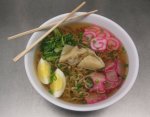 Anahola Cafe and Saimin Stand: It’s easy to pass this non-profit Hawaiian eatery hidden inside the Anahola Market Place. Open until 10pm Tuesday through Sunday with the saimin, pulled pork, and smoked pork all yummy. As a bonus, there’s a small white tent next to the cafe that sells the best huli huli chicken on the island, fire-grilled over local kiawe wood.
Anahola Cafe and Saimin Stand: It’s easy to pass this non-profit Hawaiian eatery hidden inside the Anahola Market Place. Open until 10pm Tuesday through Sunday with the saimin, pulled pork, and smoked pork all yummy. As a bonus, there’s a small white tent next to the cafe that sells the best huli huli chicken on the island, fire-grilled over local kiawe wood.
North Shore: Common Grounds Cafe, Kilauea, is now closed. Bummer! You can still take a 5-mile hike around the farm, following  the Wai Koa Loop trail to the stone dam and waterfalls. The Kilauea Fish Market, across the street from Ching Young Village (Closed on Sundays) serves super fresh fish wraps, tacos or plate dinners for about half-price of the fancy sit-down restaurants. When I was low on cash, they even allowed me order from the kid’s menu! If you’re hungry for Mexican food, Frederico’s in the Princeville Center has great carnitas and a different aqua fresca fruit juice every day. Headed to Hanalei and want to try some taro? Stop by the Hanalei Taro and Juice Company food wagon for a variety of organic vegetarian food selections. Village Snack and Bake Shop in the Ching Young Village is a local breakfast favorite. Tasty food with slow service that will help you get in the pace of life on Kauai… Lol.
the Wai Koa Loop trail to the stone dam and waterfalls. The Kilauea Fish Market, across the street from Ching Young Village (Closed on Sundays) serves super fresh fish wraps, tacos or plate dinners for about half-price of the fancy sit-down restaurants. When I was low on cash, they even allowed me order from the kid’s menu! If you’re hungry for Mexican food, Frederico’s in the Princeville Center has great carnitas and a different aqua fresca fruit juice every day. Headed to Hanalei and want to try some taro? Stop by the Hanalei Taro and Juice Company food wagon for a variety of organic vegetarian food selections. Village Snack and Bake Shop in the Ching Young Village is a local breakfast favorite. Tasty food with slow service that will help you get in the pace of life on Kauai… Lol.
Gasoline:
 The Garden Island Newspaper uses volunteers to post current gas prices. Costco has the lowest prices with unleaded gasoline usually $.025 to $.045/gallon cheaper than any other station on Kauai. If you don’t have a Costco card, gas prices in Lihue are next best, with prices about 5-cents/gallon more as you drive to the north or south. Try to avoid buying gas at the Princeville Chevron station where prices at the last gas station on the north shore are jacked super high.
The Garden Island Newspaper uses volunteers to post current gas prices. Costco has the lowest prices with unleaded gasoline usually $.025 to $.045/gallon cheaper than any other station on Kauai. If you don’t have a Costco card, gas prices in Lihue are next best, with prices about 5-cents/gallon more as you drive to the north or south. Try to avoid buying gas at the Princeville Chevron station where prices at the last gas station on the north shore are jacked super high.
Rental Cars:
Book early! There are a limited number of rental cars on Kauai, so prices spike during spring break, peak summer months and over the Christmas/New Year’s holidays, and they often sell-out well in advance. Even if you line-up a competitive rate, the state of Hawaii has mandatory taxes, fees and surcharges which can nearly double the price you’ll pay for a rental car. Ouch! Taxes and fees are highest at the Lihue Airport, so an off-site car rental company can save you some big bucks. Discount Hawaii Car Rental is a no fee booking company which has a good reputation for tracking down the best rates from a variety of rental car companies.
If you don’t care about driving a shiny new Mustang convertible, a major cost-saving option is to rent an “island car” from the Kauai Rental Car Company. You’ll roll like a local in an older model vehicle that’s likely to come with a faded paint job and a few rust spots.
Public Transportation:
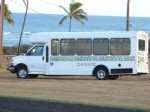
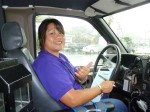
A true bargain on Kauai is the county bus system. Despite gas prices close to $5/gallon, the fare for a ride on a clean, air-conditioned bus is only $2 per boarding; $1 for seniors/children; $35 for a monthly pass. Use of the bike rack on the front of the bus is free. Buses run once an hour weekdays; every two hours weekends and holidays.
Accommodations:
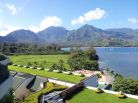 So many options on Kauai, from the funky oceanfront Beach House Hostel in Kapa’a for as little as $40/night to the 5-star St. Regis in Princeville where an ocean view suite runs more than $600/night in the off-season. Kauai also has a variety of public campgrounds where you can sleep under the stars for $3.00/night per adult.
So many options on Kauai, from the funky oceanfront Beach House Hostel in Kapa’a for as little as $40/night to the 5-star St. Regis in Princeville where an ocean view suite runs more than $600/night in the off-season. Kauai also has a variety of public campgrounds where you can sleep under the stars for $3.00/night per adult.
Before you book a reservation, you should decide which part of the island is best for you and your personal preferences. The south coast is the most popular with tourists due to Poipu’s great beaches, drier weather and broad choice of hotels and condos. The north shore has awesome beaches too, with a wetter climate that gives the mountains around Hanalei, Princeville, and Kilauea the lush tropical landscapes Kauai is known for. The east side gives guests a central location and some of the lowest accommodation prices on the island. The west side is somewhat isolated and tends to be drier and more barren than the rest of the island.
There are lots of online sites like Expedia, Kayak and Tripadvisor where you can do comparison shopping for the best hotel prices on Kauai. A multitude of realtors offer vacation rental assistance, Craigslist has a special section for vacation rentals and VRBO allows you to rent a private home or condo directly from the owner.

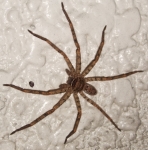 Autumn’s next vocal cord workout came when she spotted a brown cane spider (Heteropoda venatoria) in our cottage bathroom. He was only a 2-inch “baby,” but a spider with a big body and eight hairy legs can be very intimidating if you’ve never seen one before. Cane spiders are super fast, so it took me nearly a dozen tries before I could snag him with a paper towel and take him outside, unharmed, because you should never kill any of the local insect-eaters.
Autumn’s next vocal cord workout came when she spotted a brown cane spider (Heteropoda venatoria) in our cottage bathroom. He was only a 2-inch “baby,” but a spider with a big body and eight hairy legs can be very intimidating if you’ve never seen one before. Cane spiders are super fast, so it took me nearly a dozen tries before I could snag him with a paper towel and take him outside, unharmed, because you should never kill any of the local insect-eaters. I’m sorry my cousin didn’t get to see one of Kauai’s giant cockroaches (periplaneta americana) because I’m sure she would have shared my revulsion and disgust. There are multiple varieties of roaches on the Garden Isle, but my least favorite are the ones locals have dubbed “B-52 bombers” because these lovely cockroaches not only crawl… They fly!
I’m sorry my cousin didn’t get to see one of Kauai’s giant cockroaches (periplaneta americana) because I’m sure she would have shared my revulsion and disgust. There are multiple varieties of roaches on the Garden Isle, but my least favorite are the ones locals have dubbed “B-52 bombers” because these lovely cockroaches not only crawl… They fly!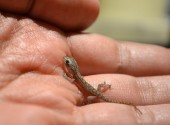 Autumn’s biggest freak out came when she encountered a tiny house gecko in the shower, clinging to her bath sponge. Some people are scared of these harmless lizards, but I think they’re cute and Hawaiians love them because they eat mosquitoes, red fire ants, and nasty cockroaches.
Autumn’s biggest freak out came when she encountered a tiny house gecko in the shower, clinging to her bath sponge. Some people are scared of these harmless lizards, but I think they’re cute and Hawaiians love them because they eat mosquitoes, red fire ants, and nasty cockroaches. During the daylight, you may get to see a colorful gold dust day gecko. We spotted this brilliant green one, with red stripes and blue eyes, at the Kauai Coffee Company plantation. A similar one was seen hanging out by the Moloa’a Fruit Stand, a perfect place for geckos that like to eat ripe fruit and drink nectar, as well as munch on a variety of insects.
During the daylight, you may get to see a colorful gold dust day gecko. We spotted this brilliant green one, with red stripes and blue eyes, at the Kauai Coffee Company plantation. A similar one was seen hanging out by the Moloa’a Fruit Stand, a perfect place for geckos that like to eat ripe fruit and drink nectar, as well as munch on a variety of insects.




